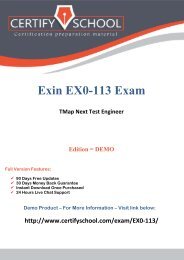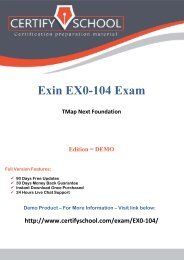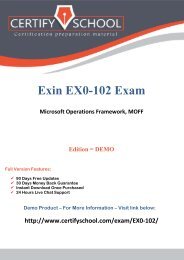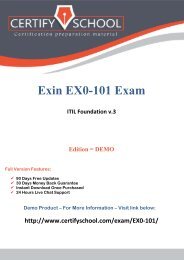CCA-470 Exam
For more Full product Details:www.CertifySchool.com Our workable study material for exam meets the exact and accurate exam questions and answers. So that’s why CertifySchool is popular in the field of IT Certification Exams material providers.Please visit site: www.certifyschool.com/
For more Full product Details:www.CertifySchool.com
Our workable study material for exam meets the exact and accurate exam questions and answers. So that’s why CertifySchool is popular in the field of IT Certification Exams material providers.Please visit site: www.certifyschool.com/
You also want an ePaper? Increase the reach of your titles
YUMPU automatically turns print PDFs into web optimized ePapers that Google loves.
www.CertifySchool.com Certification Preparation Material (PDF)<br />
Cloudera <strong>CCA</strong>-<strong>470</strong> <strong>Exam</strong><br />
Cloudera Certified Administrator for Apache Hadoop CDH4<br />
Upgrade <strong>Exam</strong> (<strong>CCA</strong>H)<br />
Edition = DEMO<br />
Full Version Features:<br />
90 Days Free Updates<br />
30 Days Money Back Guarantee<br />
Instant Download Once Purchased<br />
24 Hours Live Chat Support<br />
Demo Product – For More Information – Visit link below:<br />
http://www.certifyschool.com/exam/<strong>CCA</strong>-<strong>470</strong>/<br />
http://www.certifyschool.com/exam/<strong>CCA</strong>-<strong>470</strong>/<br />
Page | 1
www.CertifySchool.com Certification Preparation Material (PDF)<br />
Question: 1<br />
Which two updates occur when a client application opens a stream to begin a file write on a cluster running<br />
MapReduce v1 (MRv1)<br />
A. Once the write stream closes on the DataNode, the DataNode immediately initiates a black report to the<br />
NameNode.<br />
B. The change is written to the NameNode disk.<br />
C. The metadata in the RAM on the NameNode is flushed to disk.<br />
D. The metadata in RAM on the NameNode is flushed disk.<br />
E. The metadata in RAM on the NameNode is updated.<br />
F. The change is written to the edits file.<br />
Answer: D, F<br />
Explanation:<br />
Note: Namenode stores modifications to the filesystem as a log appended to a native filesystem file (edits). When a<br />
Namenode starts up, it reads HDFS state from an image file (fsimage) and then applies edits from edits log file. It<br />
then writes new HDFS state to (fsimage) and starts normal operation with an empty edits file. Since namenode<br />
merges fsimage and edits files only during start up, edits file could get very large over time on a large cluster.<br />
Another side effect of larger edits file is that next restart of Namenade takes longer.<br />
The secondary namenode merges fsimage and edits log periodically and keeps edits log size with in a limit. It is<br />
usually run on a different machine than the primary Namenode since its memory requirements are on the same<br />
order as the primary namemode. The secondary namenode is started by bin/start-dfs.sh on the nodes specified in<br />
conf/masters file.<br />
Question: 2<br />
For a MapReduce job, on a cluster running MapReduce v1 (MRv1), what’s the relationship between tasks and task<br />
templates<br />
A. There are always at least as many task attempts as there are tasks.<br />
B. There are always at most as many tasks attempts as there are tasks.<br />
C. There are always exactly as many task attempts as there are tasks.<br />
D. The developer sets the number of task attempts on job submission.<br />
Question: 3<br />
Answer: C<br />
What action occurs automatically on a cluster when a DataNode is marked as dead<br />
A. The NameNode forces re-replication of all the blocks which were stored on the dead DataNode.<br />
B. The next time a client submits job that requires blocks from the dead DataNode, the JobTracker receives no heart<br />
beats from the DataNode. The JobTracker tells the NameNode that the DataNode is dead, which triggers block rereplication<br />
on the cluster.<br />
C. The replication factor of the files which had blocks stored on the dead DataNode is temporarily reduced, until the<br />
dead DataNode is recovered and returned to the cluster.<br />
http://www.certifyschool.com/exam/<strong>CCA</strong>-<strong>470</strong>/<br />
Page | 2
www.CertifySchool.com Certification Preparation Material (PDF)<br />
D. The NameNode informs the client which write the blocks that are no longer available; the client then re-writes the<br />
blocks to a different DataNode.<br />
Answer: A<br />
Explanation:<br />
How NameNode Handles data node failures<br />
NameNode periodically receives a Heartbeat and a Blockreport from each of the DataNodes in the cluster. Receipt of<br />
a Heartbeat implies that the DataNode is functioning properly. A Blockreport contains a list of all blocks on a<br />
DataNode. When NameNode notices that it has not recieved a hearbeat message from a data node after a certain<br />
amount of time, the data node is marked as dead. Since blocks will be under replicated the system begins replicating<br />
the blocks that were stored on the dead datanode. The NameNode Orchestrates the replication of data blocks from<br />
one datanode to another. The replication data transfer happens directly between datanodes and the data never<br />
passes through the namenode.<br />
Note: If the Name Node stops receiving heartbeats from a Data Node it presumes it to be dead and any data it had to<br />
be gone as well. Based on the block reports it had been receiving from the dead node, the Name Node knows which<br />
copies of blocks died along with the node and can make the decision to re-replicate those blocks to other Data<br />
Nodes. It will also consult the Rack Awareness data in order to maintain the two copies in one rack, one copy in<br />
another rack replica rule when deciding which Data Node should receive a new copy of the blocks.<br />
Reference:<br />
24 Interview Questions & Answers for Hadoop MapReduce developers, How NameNode Handles data node failures’<br />
Question: 4<br />
How does the NameNode know DataNodes are available on a cluster running MapReduce v1 (MRv1)<br />
A. DataNodes listed in the dfs.hosts file. The NameNode uses as the definitive list of available DataNodes.<br />
B. DataNodes heartbeat in the master on a regular basis.<br />
C. The NameNode broadcasts a heartbeat on the network on a regular basis, and DataNodes respond.<br />
D. The NameNode send a broadcast across the network when it first starts, and DataNodes respond.<br />
Answer: B<br />
Explanation:<br />
How NameNode Handles data node failures<br />
NameNode periodically receives a Heartbeat and a Blockreport from each of the DataNodes in the cluster. Receipt of<br />
a Heartbeat implies that the DataNode is functioning properly. A Blockreport contains a list of all blocks on a<br />
DataNode. When NameNode notices that it has not recieved a hearbeat message from a data node after a certain<br />
amount of time, the data node is marked as dead. Since blocks will be under replicated the system begins replicating<br />
the blocks that were stored on the dead datanode. The NameNode Orchestrates the replication of data blocks from<br />
one datanode to another. The replication data transfer happens directly between datanodes and the data never<br />
passes through the namenode.<br />
Reference:<br />
24 Interview Questions & Answers for Hadoop MapReduce developers, How NameNode Handles data node failures<br />
Question: 5<br />
Which three distcp features can you utilize on a Hadoop cluster<br />
A. Use distcp to copy files only between two clusters or more. You cannot use distcp to copy data between<br />
directories inside the same cluster.<br />
B. Use distcp to copy HBase table files.<br />
http://www.certifyschool.com/exam/<strong>CCA</strong>-<strong>470</strong>/<br />
Page | 3
www.CertifySchool.com Certification Preparation Material (PDF)<br />
C. Use distcp to copy physical blocks from the source to the target destination in your cluster.<br />
D. Use distcp to copy data between directories inside the same cluster.<br />
E. Use distcp to run an internal MapReduce job to copy files.<br />
Answer: B, D, E<br />
Explanation:<br />
DistCp (distributed copy) is a tool used for large inter/intra-cluster copying. It uses Map/Reduce to effect its<br />
distribution, error handling and recovery, and reporting. It expands a list of files and directories into input to map<br />
tasks, each of which will copy a partition of the files specified in the source list. Its Map/Reduce pedigree has<br />
endowed it with some quirks in both its semantics and execution.<br />
Reference:<br />
Hadoop DistCp Guide<br />
Question: 6<br />
How does HDFS Federation help HDFS Scale horizontally<br />
A. HDFS Federation improves the resiliency of HDFS in the face of network issues by removing the NameNode as a<br />
single-point-of-failure.<br />
B. HDFS Federation allows the Standby NameNode to automatically resume the services of an active NameNode.<br />
C. HDFS Federation provides cross-data center (non-local) support for HDFS, allowing a cluster administrator to split<br />
the Block Storage outside the local cluster.<br />
D. HDFS Federation reduces the load on any single NameNode by using the multiple, independent NameNode to<br />
manage individual pars of the filesystem namespace.<br />
Answer: D<br />
Explanation:<br />
HDFS FederationIn order to scale the name service horizontally, federation uses multiple independent<br />
Namenodes/Namespaces. The Namenodes are federated, that is, the Namenodes are independent and don’t require<br />
coordination with each other. The datanodes are used as common storage for blocks by all the Namenodes. Each<br />
datanode registers with all the Namenodes in the cluster. Datanodes send periodic heartbeats and block reports and<br />
handles commands from the Namenodes.<br />
Reference:<br />
Apache Hadoop 2.0.2-alpha<br />
http://hadoop.apache.org/docs/current/<br />
Question: 7<br />
Choose which best describe a Hadoop cluster's block size storage parameters once you set the HDFS default block<br />
size to 64MB<br />
A. The block size of files in the cluster can be determined as the block is written.<br />
B. The block size of files in the Cluster will all be multiples of 64MB.<br />
C. The block size of files in the duster will all at least be 64MB.<br />
D. The block size of files in the cluster will all be the exactly 64MB.<br />
Explanation:<br />
Answer: D<br />
http://www.certifyschool.com/exam/<strong>CCA</strong>-<strong>470</strong>/<br />
Page | 4
www.CertifySchool.com Certification Preparation Material (PDF)<br />
Note: What is HDFS Block size How is it different from traditional file system block size<br />
In HDFS data is split into blocks and distributed across multiple nodes in the cluster. Each block is typically 64Mb or<br />
128Mb in size. Each block is replicated multiple times. Default is to replicate each block three times. Replicas are<br />
stored on different nodes. HDFS utilizes the local file system to store each HDFS block as a separate file. HDFS Block<br />
size can not be compared with the traditional file system block size.<br />
Question: 8<br />
Which MapReduce daemon instantiates user code, and executes map and reduce tasks on a cluster running<br />
MapReduce v1 (MRv1)<br />
A. NameNode<br />
B. DataNode<br />
C. JobTracker<br />
D. TaskTracker<br />
E. ResourceManager<br />
F. ApplicationMaster<br />
G. NodeManager<br />
Answer: D<br />
Explanation:<br />
A TaskTracker is a slave node daemon in the cluster that accepts tasks (Map, Reduce and Shuffle operations) from a<br />
JobTracker. There is only One Task Tracker process run on any hadoop slave node. Task Tracker runs on its own JVM<br />
process. Every TaskTracker is configured with a set of slots, these indicate the number of tasks that it can accept. The<br />
TaskTracker starts a separate JVM processes to do the actual work (called as Task Instance) this is to ensure that<br />
process failure does not take down the task tracker. The TaskTracker monitors these task instances, capturing the<br />
output and exit codes. When the Task instances finish, successfully or not, the task tracker notifies the JobTracker.<br />
The TaskTrackers also send out heartbeat messages to the JobTracker, usually every few minutes, to reassure the<br />
JobTracker that it is still alive. These message also inform the JobTracker of the number of available slots, so the<br />
JobTracker can stay up to date with where in the cluster work can be delegated.<br />
Note: How many Daemon processes run on a Hadoop system<br />
Hadoop is comprised of five separate daemons. Each of these daemon run in its own JVM. Following 3 Daemons run<br />
on Master nodes NameNode - This daemon stores and maintains the metadata for HDFS.<br />
Secondary NameNode - Performs housekeeping functions for the NameNode.<br />
JobTracker - Manages MapReduce jobs, distributes individual tasks to machines running the Task Tracker.<br />
Following 2 Daemons run on each Slave nodes<br />
DataNode – Stores actual HDFS data blocks.<br />
TaskTracker - Responsible for instantiating and monitoring individual Map and Reduce tasks.<br />
Reference:<br />
24 Interview Questions & Answers for Hadoop MapReduce developers, What is a Task Tracker in Hadoop How<br />
many instances of TaskTracker run on a Hadoop Cluster<br />
http://www.certifyschool.com/exam/<strong>CCA</strong>-<strong>470</strong>/<br />
Page | 5
www.CertifySchool.com Certification Preparation Material (PDF)<br />
Demo Product – For More Information – Visit link below:<br />
http://www.certifyschool.com/exam/<strong>CCA</strong>-<strong>470</strong>/<br />
Thanks for Using Our Product<br />
http://www.certifyschool.com/exam/<strong>CCA</strong>-<strong>470</strong>/<br />
Page | 6


















